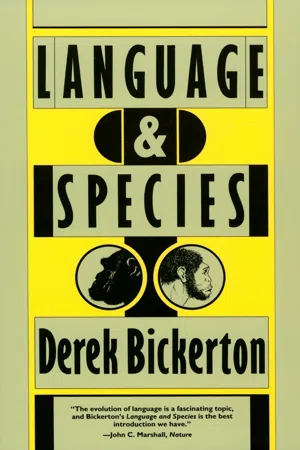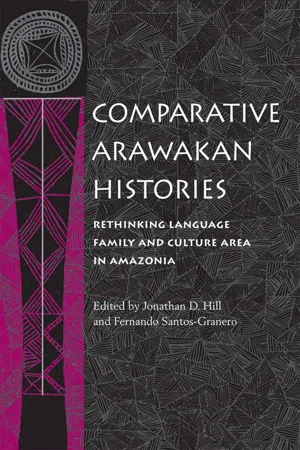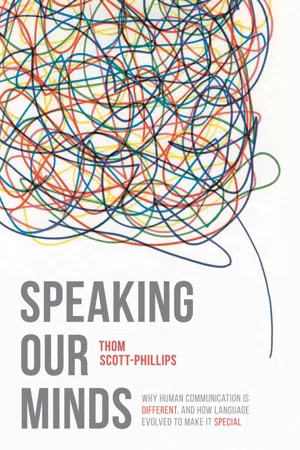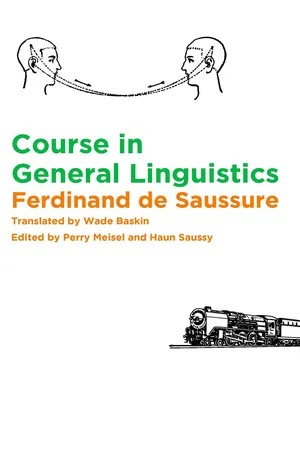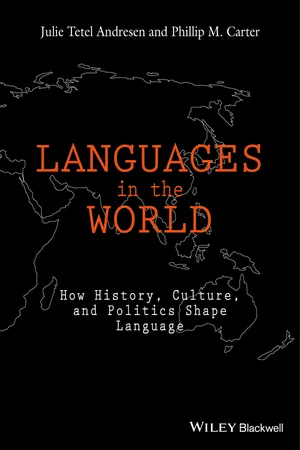Languages & Linguistics
Proto Language
A proto language is a reconstructed ancestral language from which a group of related languages are believed to have evolved. Linguists use comparative methods to identify common features and reconstruct the vocabulary and grammar of proto languages. These reconstructions help trace the historical development and relationships between different languages within a language family.
Written by Perlego with AI-assistance
6 Key excerpts on "Proto Language"
- eBook - ePub
- Derek Bickerton(Author)
- 2018(Publication Date)
- University of Chicago Press(Publisher)
6 The World of Protolanguage The one thing we know for certain about the origin of language is that it emerged somewhere between the separation of the hominid line from other primates and the dawn of recorded history. Everything else is speculative to some degree. Yet if evidence from a variety of sources is taken into account, it should be possible to produce a scenario explicit enough to be tested against future discoveries. It seems not unreasonable to assume that what first emerged was a protolinguistic mode lacking most or all of the formal structural properties that characterize language. Several considerations support such an assumption. First, as suggested in chapter 5, such a mode forms part of human ontogeny and remains accessible to all members of the species throughout life. The case of Genie also suggests that it might be more robust than true language, requiring less in the way of triggering, or at least not requiring triggering to take place within a relatively narrow developmental window. The mode is also accessible, given adequate training, to other primates (and indeed perhaps to a wide range of other species). From this we may conclude that the spontaneous emergence of such a mode, though it would have required factors not present in other species, need not have required anything either particularly novel or particularly elaborate in the way of neural infrastructure. Moreover, the protolanguage hypothesis is consistent with the duality of language shown in chapters 2 and 3. Language as our species knows it consists of two easily separable components: a maplike representation that uses hierarchically structured categories, and an itinerary-like representation that generates sentences (formally structured propositions) drawn from the contents of this map - eBook - ePub
Comparative Arawakan Histories
Rethinking Language Family and Culture Area in Amazonia
- Jonathan D. Hill, Fernando Santos-Granero, Jonathan D. Hill, Fernando Santos-Granero(Authors)
- 2010(Publication Date)
- University of Illinois Press(Publisher)
Apurinã is the language I have been working on for the last ten years, having recently concluded a preliminary (still unpublished) descriptive grammar of the language (Facundes 2000b). The Apurinã data used here come exclusively from the various field trips I have made to eleven Apurinã communities in the State of Acre and along the Purus River in the State of Amazonas in Brazil, between 1990 and 1997. The data from Piro come from Matteson (1965, 1972b). The data from Iñapari come from Parker (1995). The clustering of Apurinã, Piro, and Iñapari as members of a branch of Arawak has already been implied by the classification given in Payne (1991, 364). The attempt at a reconstruction presented here provides some preliminary information on which basis a branch within Arawak can be verified later on, as the information brought about by the partial phonemic reconstruction of Proto-Apurinã-Piro-Iñapari (P-API) is compared with the reconstructions available for Proto-Arawak and its subgroups. Furthermore, the fact that API are all Arawakan languages has already been demonstrated by previous comparative works (see Valenzuela 1991; Payne 1991; and Aikhenvald 1999a).The method used in analyzing the data of the three languages is the comparative method briefly described earlier. The proper presentation of the comparative analysis, including a detailed presentation of the data used and the various steps of the investigation, would require a separate essay; therefore, I focus on the results of the comparison and refer to Facundes (2000a) for the details of the analysis and the data, where the reader will find the information necessary to verify the plausibility of every set of correspondences and the cognates themselves.Before presenting the results of the analysis, I must introduce a few terms that are part of the linguistic jargon (following, in general, the wording by Campbell 1999, 111–12). A protolanguage is the ancestral language from which daughter languages descend and can be reconstructed if the application of the comparative method is successful. Sister languages are languages that are related to one another as daughter languages that descend from the same ancestor (protolanguage). A cognate is a word or morpheme that is related to another word or morpheme of a sister language insofar as both derive from the same word or morpheme of the protolanguage. A cognate set is the group of words or morphemes that are related to one another because they descend, or have been inherited, from the same word or morpheme of the protolanguage. A sound correspondence is the set of sounds that are found to correspond to one another in the cognate set by virtue of having descended from a common ancestral sound. The reflex is each sound that descends from a common ancestral sound in the protolanguage and is found in the sound correspondences of the daughter languages. Shared retention is the linguistic property that “different daughter languages inherit unchanged from the proto-language regardless of whether the daughters belong to the same subgroup [of languages] or not” (Campbell 1999, 173). Shared innovation “is a linguistic change which shows a departure (innovation) from some trait of the proto-language and is shared by a subset of the daughter languages” (Campbell 1999, 170). - eBook - ePub
Speaking Our Minds
Why human communication is different, and how language evolved to make it special
- Thom Scott-Phillips(Author)
- 2014(Publication Date)
- Bloomsbury Academic(Publisher)
Where does grammar come from? To begin to answer this question, we must first look at what a language without grammar might look like: a ‘proto-language’, if you like. 5.4 A pragmatic perspective on protolanguage He was not the first to use the term, but the widespread adoption of the term protolanguage owes a great deal to the work of the linguist Derek Bickerton (1990). It has since entered the jargon of evolutionary linguistics, as a useful way to refer to the earliest languages, those that have not yet developed the sort of properties we associate with more developed languages. Exactly what form protolanguages took, and how they subsequently developed into languages proper, are both disputed topics. However, like too much research on the origins of language, the importance of pragmatics, and in particular of ostension and inference, is sorely neglected in these discussions (an exception is Smith, 2008). In this section I will describe what a pragmatic perspective tells us about the nature of protolanguage. There are two established schools of thought with regards the evolution of protolanguage. The first is the synthetic approach, so called because it emphasizes how different elements are synthesized together. It is also sometimes called the compositional approach, because it emphasizes how larger units are created by the composition of smaller units. The basic idea is that languages develop as linguistic elements that are then combined together in increasingly complex ways. The first conventions are, in effect, the building blocks with which more complex constructions are created - eBook - ePub
The History of English
A Student's Guide
- Ishtia Singh(Author)
- 2013(Publication Date)
- Routledge(Publisher)
It perhaps goes without saying that all such work is always going to be controversial. The majority of historical linguists, while having a better than average grasp of the workings of various languages, have a less than superhuman knowledge of all of them. Knowledge of the various language families therefore tends to be specialized, and it is difficult, if not impossible, to wholly endorse or productively scrutinize groupings which include families with which the researcher is not familiar. It is possible too that certain groupings contradict researchers’ perceptions about genetic affiliations, and their reactions are consequently negative: Trask (ibid.: 379), for example, states that racist perspectives once precluded the incorporation of Chadic, whose native speakers are predominantly Black, into the larger Afro-Asiatic family, which contains languages whose speakers are primarily White. There is also a very real issue of time-depth. We know that languages undergo continuous change and given enough time (say, a few thousand years) can evolve in mutually unintelligible forms, despite a genetic relationship. In addition, the written record is relatively sparse – many languages have never been written down, no known text is more than five thousand years old, and no language's entire history to date is represented by available texts. Consequently, as we have seen, proto-forms, both at the head of and within a language family, have typically had to be reconstructed. Because the comparative method is well established in reconstructive methodology and possibly also because such reconstructed forms have an anchor in actual data, we have come to accept that by and large, ‘shape’ can be given to languages spoken up to about eight thousand years ago (bearing in mind, of course, issues such as semantic change). However, when the reconstructions themselves become the database for further reconstructions, researchers may be forgiven for becoming somewhat nervous. Remember that reconstruction can depend heavily on the database used, as well as on what the researcher considers plausible avenues of change. Given this measure of subjectivity, the use of unattested forms as ‘DNA’ for hypothetical languages such as Proto-Nostratic, for example, which, if it had existed, would have been spoken 10,000–15,000 years ago, or for Proto-World (up to at least 100,000 years ago), leaves even the most supportive linguist feeling rather unsettled. We are left in the position of only being able to say whether such reconstructions, given the database used and the methodology employed, are plausible; but they bring us no closer to verifying or falsifying the existence of such early languages or their genetic affiliations. Therefore, what is typically presented as an exercise in rationality is very often an act of faith, which may go some way towards explaining the sometimes personal vehemence of the criticisms levelled against this kind of work. - eBook - ePub
- Ferdinand de Saussure, Wade Baskin, Perry Meisel, Haun Saussy(Authors)
- 2011(Publication Date)
- Columbia University Press(Publisher)
ges-tus) immediately brings to light the diachronic unity which relates both signs to a prototype that can be reconstructed inductively. The more numerous the comparisons, the more accurate inductions will be, and the results-if sufficient data are a t hand-will be true reconstructions.The same applies to languages in their totality. We can infer nothing about Basque; because it is isolated, there is nothing with which we can compare it. But by comparing a group of related languages like Greek, Latin, Old Slavic, etc., scholars were able to single out the common original elements and to reconstruct the essentials of Proto-Indo-European as it existed before differentiation in space occurred. What was done for the whole family on a large scale was repeated on a smaller scale—and always by the same procedure—for each of its parts wherever this was necessary and possible. We know numerous Germanic idioms directly, through documents, but we know Proto-Germanic—the source of these different idioms-only indirectly, through the reconstructive method. Using the same method with varying success, linguists have also sought the original unity of other families (see p. 192).The retrospective method, then, takes us far beyond the oldest documents in tracing the history of a language. Thus it was possible to draw the prospective outline of Latin, whose history hardly begins before the third or fourth century B.C ., only after the reconstruction of Proto-Indo-European had given an inkling of what must have happened between the period of original unity and the first known Latin documents.With respect to reconstruction, evolutionary linguistics is like geology, another historical science. Geology sometimes has to describe stable states (e.g. the present state of Lake Geneva Basin) without considering what might have preceded in time, but its main concern is the chain of events and transformations that make up diachronics. A prospective geology is conceivable, but in reality the viewpoint is usually only retrospective. Before recounting what has occurred at a given point on the earth, the geologist must reconstruct the chain of events and try to determine what is responsible for the present state of that part of the globe. - eBook - ePub
Languages In The World
How History, Culture, and Politics Shape Language
- Julie Tetel Andresen, Phillip M. Carter(Authors)
- 2015(Publication Date)
- Wiley-Blackwell(Publisher)
Hopefully, you have appreciated from reading this chapter that attitudes about languages almost never have anything to do with the languages themselves but rather are attitudes about speakers. If this is the case, where do attitudes about language come from? What kinds of storylines did you hear as a child about the language varieties in your community and beyond?What are the power and solidarity language varieties spoken in your community? How do you suppose those particular language varieties achieved those particular statuses? Can you imagine that the power language variety could ever become the solidarity language variety and vice versa? If so, what kinds of conditions (social, political, economic, etc.) would need to be in place for that reversal to happen?A key word in this text is contingency. What does it mean to describe something as contingent? What does it mean to describe language, or a specific language variety, as contingent? Contingent on what?Notes
1 He was knighted upon his arrival in India and is known in history as Sir William Jones.2 A protolanguage is a common ancestor language, which has produced at least one descendant. It is not by definition one without written records. It simply happens to be the case that the protolanguages reconstructed for the major language stocks of the world antedate written records.3 The term family refers to a group of languages that are related at a time-depth of 2500–4000 years.4 The term stock refers to a group of languages that are related at a time-depth of 5000–10,000 years ago.5 The Austronesian stock was recognized as early as 1706 but not fully worked out.6 The term phylum refers to a group of languages that may have more or less evidence of being related at a time-depth greater than 10,000 years.7 Roma is the language spoken by the Roma people, erroneously called Gypsies because it was once believed they came from Egypt. DNA studies confirm the linguistic evidence linking Roma to other Indo-Iranian languages, in that three genetic markers found in a study of Roma groups in Bulgaria show the same chromosomal background as Indian and Pakistani subjects (Kalaydjieva et al. 2005).8
Index pages curate the most relevant extracts from our library of academic textbooks. They’ve been created using an in-house natural language model (NLM), each adding context and meaning to key research topics.
Explore more topic indexes
Explore more topic indexes
1 of 6
Explore more topic indexes
1 of 4
